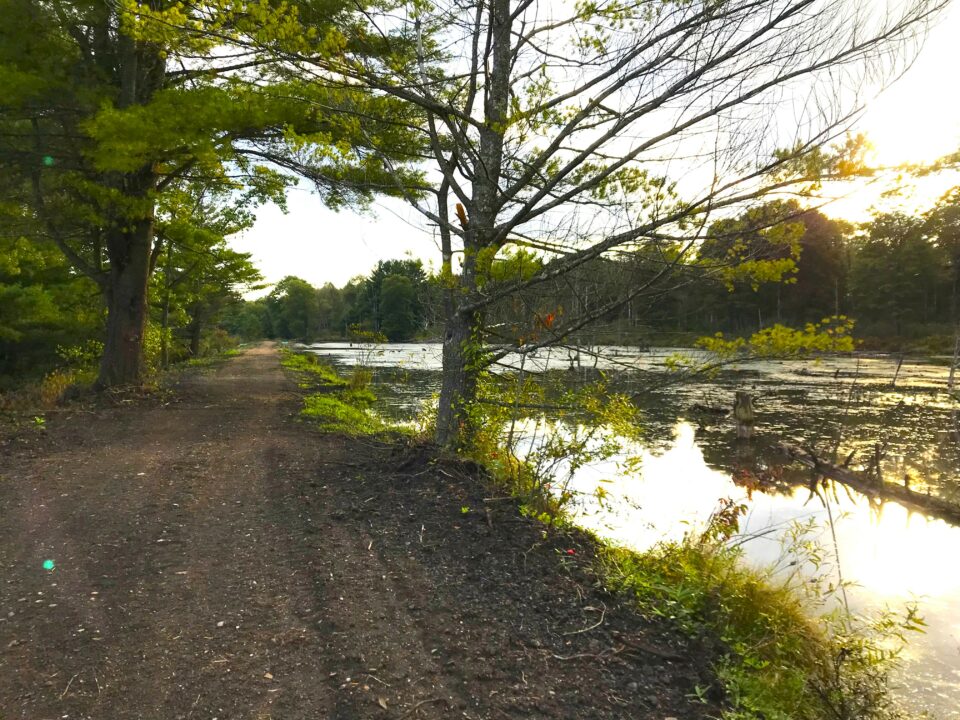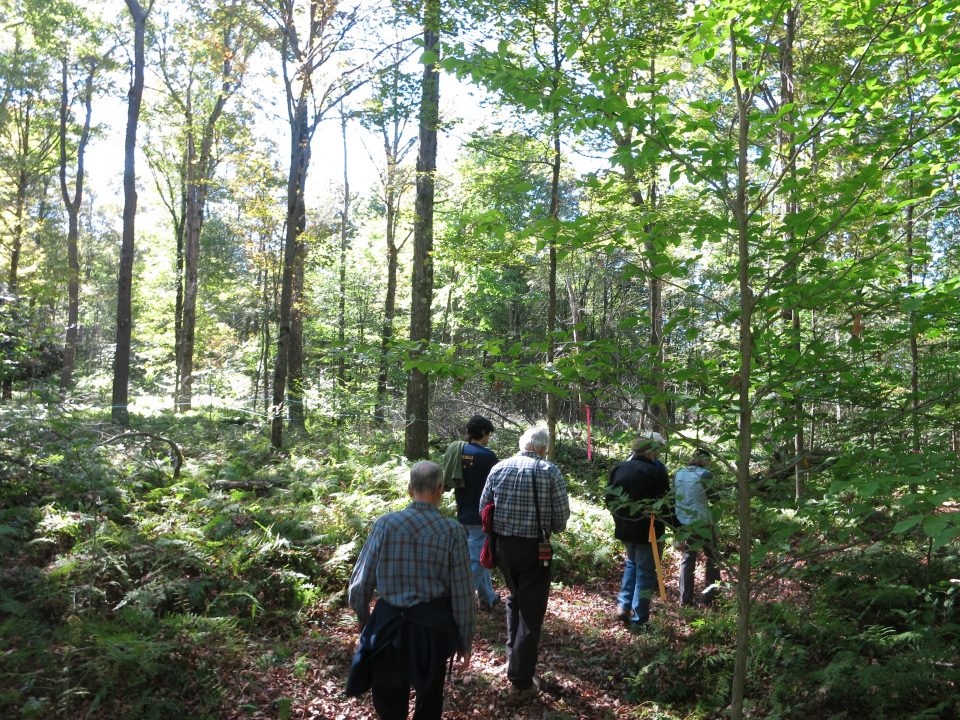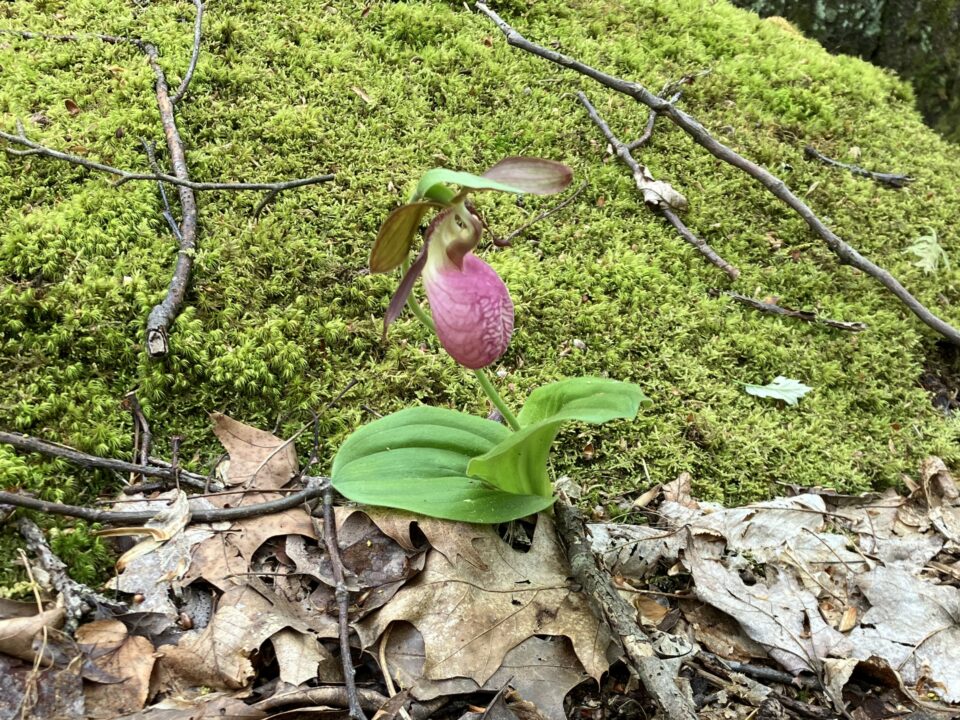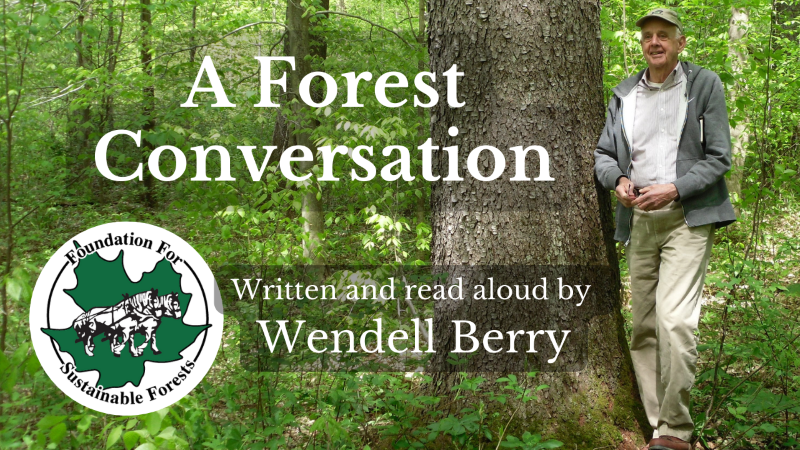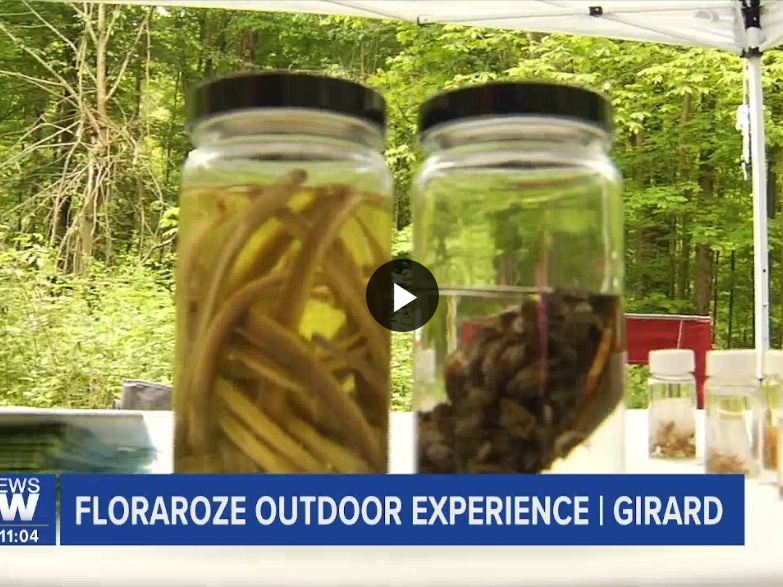About the Project
The Caldwell Creek Watershed Conservation Project began in 2012 with the Foundation for Sustainable Forests’ purchase of 60 acres, and has grown to over 1,200 protected acres across eight properties today. With over 10,000 feet (nearly 2 miles) of creek frontage, FSF’s protected lands in the watershed help to preserve watershed health, promote sustainable forest management, and provide recreational opportunities. Numerous conservation partners have joined forces to expand recreation access in the watershed and improve the health of Caldwell Creek through projects including streambank erosion prevention, riparian tree restoration, and fish habitat enhancement.
The most recent land acquisition of the Caldwell Creek Watershed conservation project was the Dotyville Hill Forest in 2021. This 528-acre forest comprises four adjacent parcels - three donated by founder and FSF president Troy Firth, and one purchased from private ownership. Support for this acquisition was made possible by a grant from the PA Department of Conservation and Natural Resources’ Community Conservation Partnerships Program, as well as assistance from the John Nesbit Rees and Sarah Henne Rees Foundation of Titusville, Trout Unlimited’s Caldwell Creek and Northwest PA Chapters, and James & Vicki Stec of Pittsfield.
Caldwell Watershed Conserved Properties
Watersheds and Forests

A red eft (land-dwelling life stage of the eastern newt) enjoys the view of Caldwell Creek. Photo by Western Pennsylvania Conservancy
Watersheds are areas of land whose rainwater and snowmelt funnel water into a stream, lake, or wetland. These water bodies provide us with drinking water, water for agriculture and manufacturing services, and opportunities for recreation. Conserving watersheds means that a lake, river, or stream is protected by managing the land from which its water drains.
The Foundation currently manages approximately 1,200 acres of land within the Caldwell Creek watershed. Through our mission of conserving and promoting working forests, FSF forms a direct link between healthy forests and healthy streams. The management techniques involved include horse logging, invasive species removal, and maintaining forest diversity and resilience. Using horses to skid logs rather than heavy machinery involves less soil disturbance throughout the forest. Keeping this top layer of soil intact helps to prevent it from eroding into the stream. Maintaining woody vegetation along streams helps to filter sediment during storm events, and remove nitrogen and phosphorus leaching from nearby agricultural land use from reaching the stream.
Some wildlife species represent the health of the ecosystem and are known as indicator species. The presence of native trout often indicate a healthy stream as they are sensitive to water quality, water temperature, and macroinvertebrate availability. Monitoring of these species - like the native brook trout in Caldwell Creek - are vital in determining the status of an ecosystem. A decline in their population could represent environmental problems such as runoff, pollution, or erosion. A healthy population represents an ecosystem that is operating under its normal conditions, which will continue to provide services that humans and wildlife depend on. These factors dictate the adaptive nature of the management within the Caldwell Creek watershed.
Watershed History
Pieces of century-old history can also be found along Caldwell Creek. After the first settlers arrived in Warren in 1806, they realized the timber potential of the region, which was supported by the Allegheny River and its tributaries for the rafting of lumber. The Caldwell Creek Lumber Company, one of many in the region, was established in 1884 by several investors in Eldred Township. A steam-powered sawmill operated by the company was located in the area where Three Bridge Run joins Caldwell Creek. This operation managed a 4000 acre tract of land with a mill that processed 40,000 board feet of pine, hemlock, and hardwood lumber. An eight-mile railroad was constructed to connect the mill to the New York Central line at Selkirk. A ten ton vertical boiler Class A Climax locomotive, made nearby in Corry, PA, was purchased and installed in May of 1888 to keep the mill supplied with logs and transport finished lumber to Selkirk. Today, remnants of the mills and lumber dams located in the region can be seen during low water periods along Caldwell Creek.
FSF board member and conservation easement donor Bob Slagter has witnessed an increase in gas well drilling and development throughout the watershed over the years. With this increase in land modification, Slagter commented on his perceptions of how this has affected the creek, “Over the years the advent of many gas wells drilled in the valley, the pipelines installed, and their roads have contributed to silt running off into the creek. We’ve attempted to address this issue with the Pennsylvania Fish & Boat Commission through several restoration projects.” More recently, the landscape is becoming fragmented for the development of camps due to its recreational appeal.

An abandonded turn-of-the-century oil well casing puller in the Dotyville Hill Forest
Restoration and Habitat Improvement
As one of the first properties of the Caldwell Creek project, the 85-acre Savitz Forest was purchased in 2012 and includes significant frontage along Caldwell Creek. In the fall of 2013, the Western Pennsylvania Conservancy (WPC) and the Pennsylvania Fish & Boat Commission (PFBC) led Phase I of a streambank enhancement and fish habitat improvement project that stabilized ~1,000 feet of bank south of Savitz Forest.

Phase I, construction in progress. Green oak boards installed between facelogs and banks on a mudsill. Photo by WPC

Phase I, one year later. Photo by WPC
In 2019, WPC and PFBC completed Phase II at Savitz Forest with the fortification of another 550 feet of stream bank. The path from the Flat Road public fishing access parking area takes you to this section of Caldwell Creek where you can see various structures made of stone, logs, and tree root wads placed in and along the creek. These structures slow the water, preventing erosion and sedimentation, while providing habitat for many in aquatic wildlife species.

Phase II, eroded streambank before restoration. Photo by WPC

Phase II, same section of stream bank immediately after construction. Photo by WPC
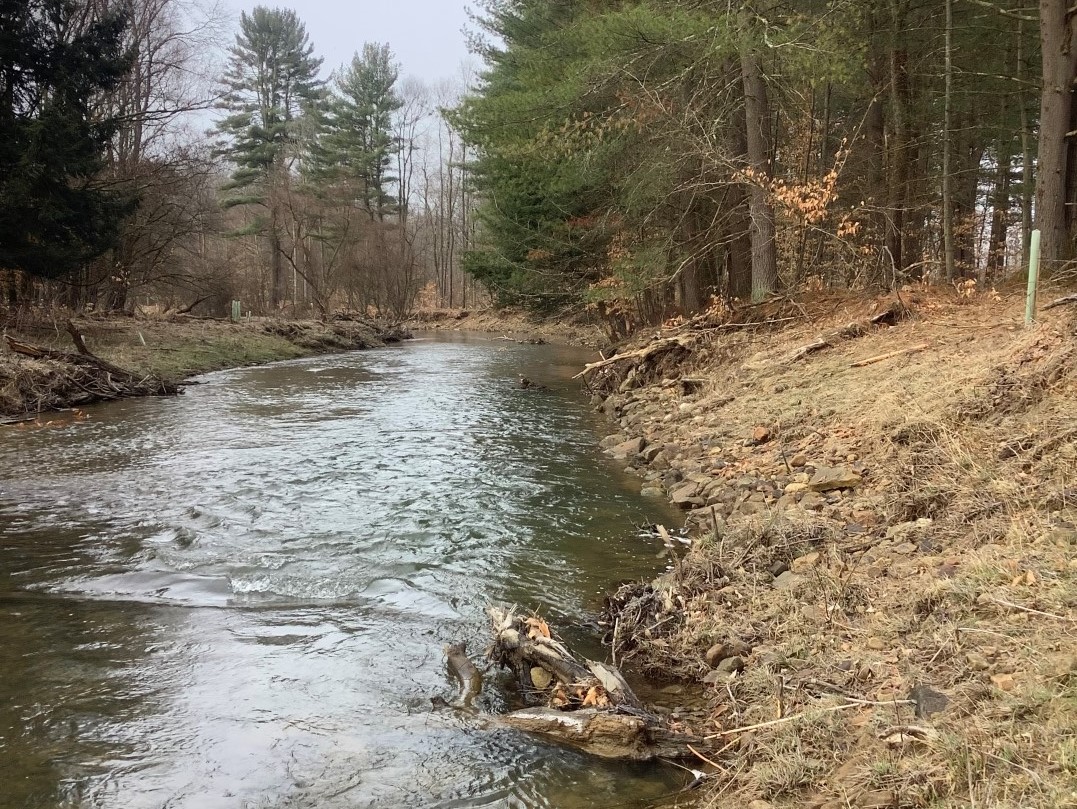
Phase II, same section of stream bank two and a half years after restoration. Photo by WPC

Phase II, PFBC and WPC staff and volunteers position and secure logs for a modified mudsill. Photo by WPC

Phase II, PFBC staff position face logs (parallel to stream flow), to be placed on top of sill logs (perpendicular to flow and entrenched into the bank), and secured with rebar for a modified mudsill. Photo by WPC

Phase II, modified mudsill awaiting rock ballast during construction. Photo by WPC
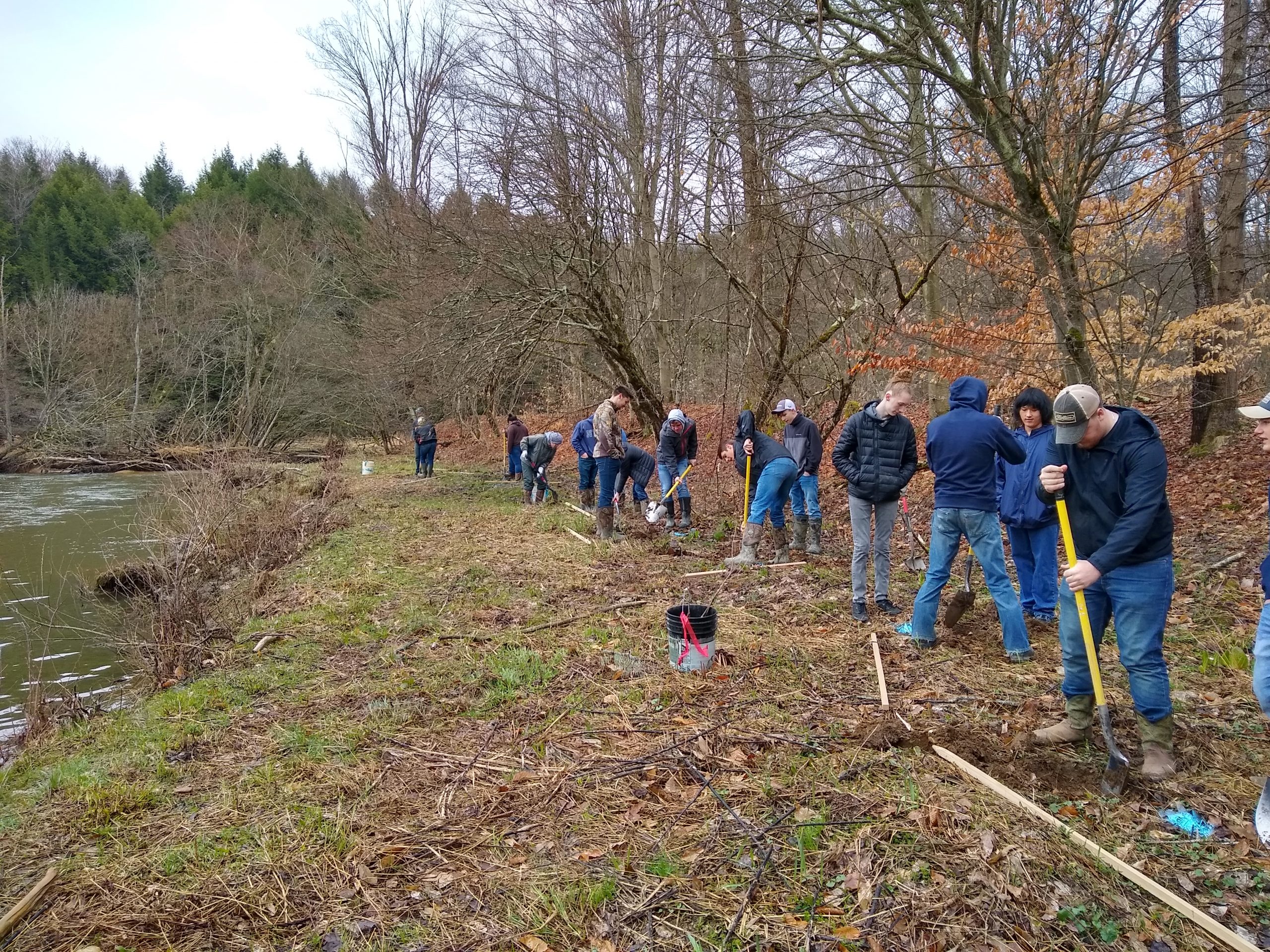
Phase II, volunteers plant trees on a graded section of bank, 2019.
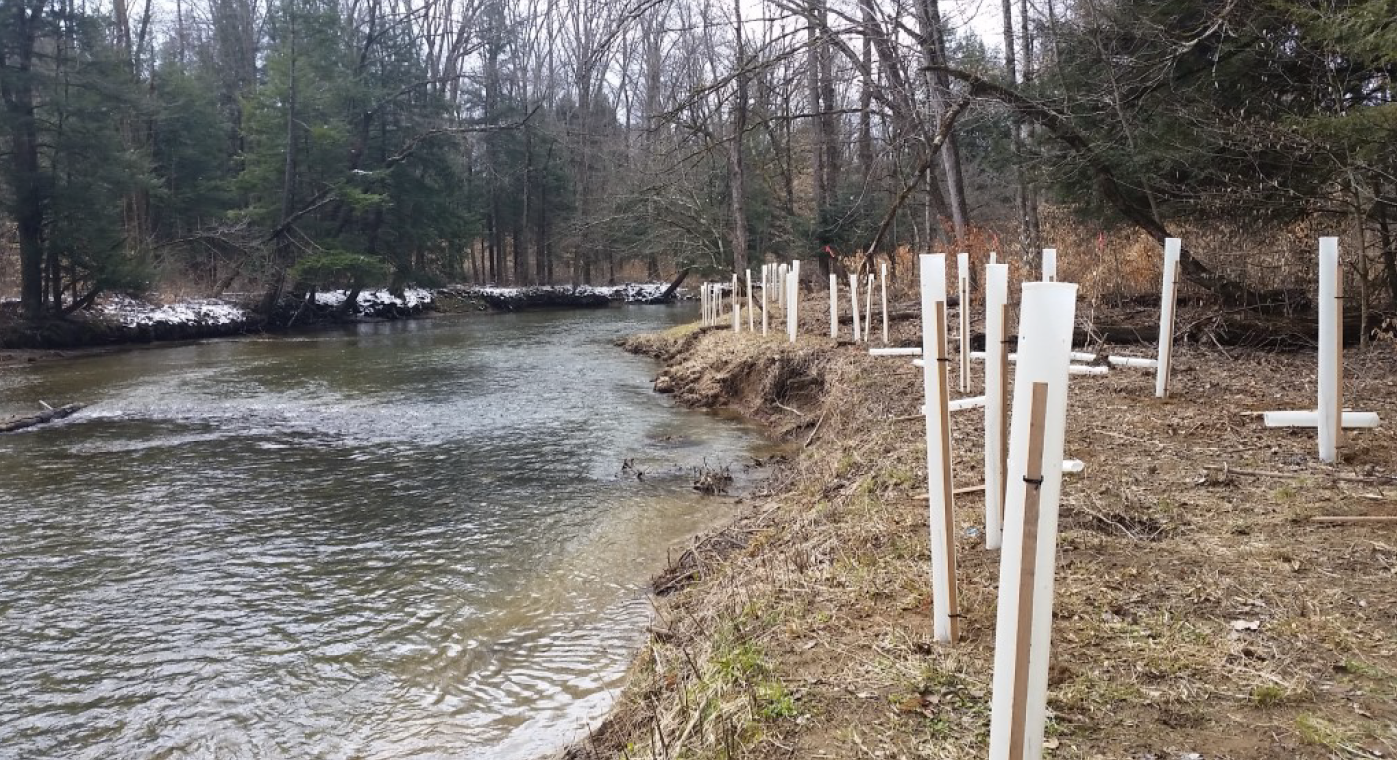
Young trees line the creek on Bob’s property in 2018 after 40 high schoolers spent a day planting with him.
In spring of 2018, the PA Department of Conservation & Natural Resources (DCNR), the USDA Natural Resource Conservation Service (NRCS), and 40 high schoolers assisted the Foundation with planting 435 trees along a riparian buffer on the Slagter Forest Easement. The roots of these trees will help to keep the stream bank from eroding, and the future canopies of these trees will provide shade which will protect Caldwell’s cold water. In a contribution to a Foundation newsletter, Bob Slagter, donor of the Slagter Forest conservation easement, commented “If you are considering a planting project, contact any of the agencies mentioned above. You will help the forest, help the water, help the kids as they ‘Plant Their Future,’ and you will learn that we are leaving the world in very good hands.” Building upon this work, WPC and DCNR completed additional riparian tree plantings on FSF’s Savitz property in 2021 and 2022.
You will help the forest, help the water, help the kids as they ‘Plant Their Future,’ and you will learn that we are leaving the world in very good hands.
Another habitat improvement project took place on the Slagter conservation easement in early 2020. In collaboration with the NRCS’s Cerulean Warbler program, a deer exclosure fence was constructed around 15 acres of the property. Following the removal of undesirable trees and invasive plant species, the fence will provide new forest growth the time and space to regenerate without the pressure of deer browsing. In the years following this project, FSF will monitor the regenerating forest to ensure that diverse native tree species are beginning to develop into the future overstory.

Cerulean Warbler
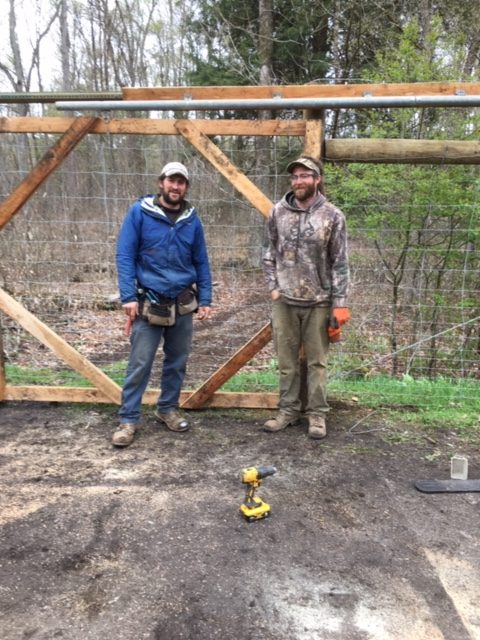
FSF board member Pat Maloney (left) during construction of the deer exclosure fence at Slagter Forest.
Recreation
Caldwell Creek and its tributaries are locally famous for high quality trout fishing. The Pennsylvania Fish and Boat Commission (PFBC) recognizes a section of the West Branch of Caldwell Creek as a Class A wild trout stream, designating a long-term breeding population of wild trout that is suitable for sport fishing. The PFBC stocking program also supplements Caldwell Creek with brown trout and the West Branch with rainbow trout. Native brook trout are also found in the watershed. Some areas in the Caldwell watershed are managed under special fishing regulations, including a catch-and-release fly fishing only portion of Caldwell Creek and a catch-and-release artificial lures only stretch of the West Branch of Caldwell Creek.
The Northwest Pennsylvania and Caldwell Creek Chapters of Trout Unlimited were instrumental in the creation of these special fishing regulation areas in the 1950’s. Since then, these Trout Unlimited chapters have partnered with PFBC and FSF to provide additional access to the Caldwell Creek fishery, survey trout populations to evaluate the effectiveness of stocking programs, and improve fish habitat in the watershed.
Click the buttons below for more information about special fishing regulation areas, stocking locations, and Class A wild trout stream designations.

Photo by Greg Kedzierski, angler John Tautin

To ensure additional and continuous public fishing access, PFBC has worked with private landowners in 2013 to secure five fishing access easements covering 2.95 miles along Caldwell Creek. These areas provide public access to the creek for walk-in fishing and riparian management. The boundary of the public fishing access area is marked by signs, such as the one in the image to the left.
Other activities such as hunting, hiking, and nature-observing can also be enjoyed on many of FSF’s properties in the watershed. For more information about which properties are open to the public, driving directions, and property histories, please visit the “Explore” section of our website.
In early 2022, the Foundation received a $5,000 MTN DEW Outdoor Grant that will be used to add public parking access to the fly-fishing corridor of Caldwell Creek, as well as signage that describes the recreational opportunities and management strategies of the FSF’s properties within the watershed.

